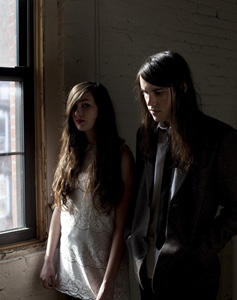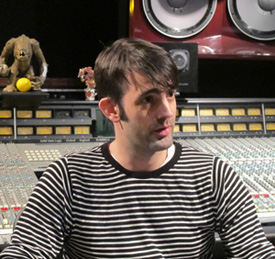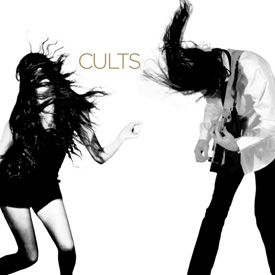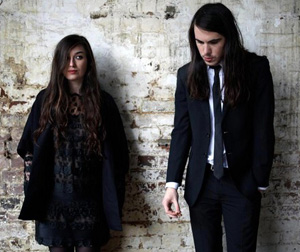Behind The Release: “Cults”
Before Sony’s Columbia record label picked up the Brooklyn band Cults, they made do with a spare Bandcamp page and a text-only website to list upcoming shows.
Bloggers world-round seemed to marvel at the band’s ability to ignite industry interest without Facebook and Myspace – much like the rest of us wonder how we were ever able to meet at a pre-designated time and place before cellphones existed.
(Hint: Being good at what they do and having ties to the industry didn’t hurt.)
At their best, Cults offer simple, unpretentious, catchy pop tunes with a startlingly-retro production sensibility.
It’s a sound that’s novel and familiar at once, playing on the ear like a cross between The Ronnettes and Peter Bjorn and John.
We talked at length with co-producer and engineer Shane Stoneback who used a combination of vintage and modern tools to help the band craft huge, hazy, reverb-drenched mixes to complement their casually-cultivated air of mystery.
STONEBACK’S STORY
“Are you looking for work? Because I just fired somebody 30 minutes ago.”
The man facing Shane Stoneback was a large one, heavy-set and imposing. He carried a sandwich in one hand and a microphone in the other.
Stoneback, who would go on to work with Cults, Vampire Weekend, Sleigh Bells, F*d Up, and The Magic Kids, told a fateful lie: He said yes.
“Good. I’m going to sit in the lounge and eat this sandwich.’’ The studio manager passed him a Neumann U87 with his other hand. “By the time I come back, have this up so I can hear it in the headphones.”
The year was 1999. Stoneback was on vacation, visiting New York City from Minneapolis where he already had an entry-level job at recording studio.
In what he would later consider “a naïve move,” Stoneback had thumbed through the alphabetical Recording Industry Source Book; making phone calls, hoping to secure a quick tour at one of New York’s flagship studios.
By the time he got to the letter “B”, someone said yes. He found himself in Battery Studios, the home of Jive records, being asked if he wanted a job.
‘This was in their C-room,” says Stoneback. “They had a digital Euphonix console in there. I never would have been able to figure that thing out in time, but I plugged the mic in, and somehow, I heard the headphones click. Whoever used the room before me hadn’t disconnected anything yet! That was it. I got the job and I never came back from vacation.”
If you ask Shane Stoneback about it, he’ll tell you he’s just a lucky guy.
From that encounter, he ended up working for Jive records during its heyday. The experience afforded him what he considers an “amazing pop training,” assisting on sessions with the biggest selling pop-artists of the day: Britney Spears. Backstreet Boys. ‘N Sync.
When Zomba Corporation (and in turn, Jive) was bought out by Sony, their Battery recording studios closed down. Again, Stoneback says he got lucky: He was unemployed for an afternoon. That once sandwich-toting manager had lined him up with a job at a post-production house called Sound One, where he would help veteran film mixers learn their new Pro Tools systems.
But to say it was all luck would discount the 8-hours Stoneback would put in each night after the studio closed up each evening. After hours, he spent his time recording whatever interesting local bands he could find.
“They had a closet full of LA-2A’s and old Neve components – all this stuff that was just kind of old and irrelevant in their work. I got to put some of this stuff into a series of road cases and wheel it all into the studio at night. And they were cool about it, as long as in the morning, the place looked like a post-production room again.”
He’d meet Vampire Weekend through colleague Jeff Curtin (Those Darlins’, Vampire Weekend, Small Black). Sensing they were set to make waves, he “dropped everything” to help them finish their record at Treefort recording, the new Brooklyn studio he had started to build.
That band would go on to receive rave reviews, immense popularity, wide notoriety, and a healthy dose of media backlash. (More on that later.)
From then on, Stoneback was keyed into a world of novel and emerging NYC artists, and into the rolodexes of label executives.
“If you get one legitimate credit under your belt,” says Stoneback ,”it kind of spirals into all these other projects from there.”
CULTS
When Stoneback met Cults, they already had a sound. Two songs on an internet web page had been all it took to get the right people talking. They called Stoneback, not to reinvent their sound, but to reinforce it.
“Ultimately, we didn’t change much from the original demos,” Stoneback says of the songs that had already made waves.
“We re-recorded one or two things, maybe even tried some new vocals, but in the end it was pretty clear there was some kind of magic about those tracks already.”
“I did go back into the mixes to beef them up a little bit – Just to make them slightly more modern-sounding.”
“As much as there’s this late-50s/early-60s girl-group aesthetic that’s so obvious, a lot of the songs have these almost Outkast-style hip-hop beats underneath them. So I’d add a little bit of low end to each of the mixes, maybe a little more smack to the snare, so they’d have this sort of strange duality of a 50s girl-group with a secret club-banger element going on underneath.”
When listening, it’s easy to imagine the Cults LP as being faithfully captured with vintage equipment and then amped-up with more modern tools. But much of the time it turns out, the opposite approach was at play.
TOOLS, TWEAKS, AND TONES
“I have this old Silvertone amp [model 1472] that’s just beat to sh*t. People call it the ‘TV amp’ because of the way it looks. It’s just a small combo amp with two channels that you can kind of hot-rod together. It’s got a really simple tube circuit and a slightly torn speaker that adds to that kind of broken magic quality. I’ve used it on almost every record I’ve done.”
“That was a big part of the keyboard sounds. A lot of those sounds were coming off of a really modern sounding keyboard – a software version of an FM-synthesizer really. But with that amp, it all came back sounding really vintage and authentic.”
Similarly, vocals were recorded to a DAW through a modern-sounding microphone, then degraded to become an almost-impressionistic exaggeration of an old-school sound.
The team decided early on that, although the albums should ultimately feel more like a collection of songs recorded on different dates with different setups, they’d stick with the main kick and snare sound songwriter and co-producer Brian Oblivion created for their demos. Even when they recorded live drum tracks, they would reinforce them with the kick and snare sounds that had originally come come from a drum machine on Oblivion’s computer.
To sonically warp the voice, drums and instruments, Stoneback used Roland Space Echo extensively – not as a delay, but as a sound-shaping tool.
[For those who aren’t familiar with it, the Space Echo is a vintage effects box that uses a small tape cartridge to deliver delay effects. Some of the later models feature a spring reverb, even chorus. This one did not -Ed.]
Stoneback would set the unit for a quick, single repeat. But instead of combining the output of the Space Echo with the original sound to achieve a traditional slap-back delay, he would record the tape-delayed signal into Pro Tools, and slide it back in time to replace the original sound.
“It’s kind of like a tape plugin but with all the genuine foibles of tape. And there’s really no worse tape machine than a Space Echo!” Stoneback laughs.
“I mean the quality is just asinine. But it was perfect. The first time I tried it out as a test, [the band] just loved it. It probably wouldn’t stack well if you wanted to record 9 tracks of vocals. There could be a lot of buildup in one [frequency range] .. Maybe, 2k[Hz]. But for this it was great.”
The work was tedious he says, but worth it:
“The Space Echo tapes have these little splices on them. So if you play it all the way through you’ll hear a glitch each time the tape comes around. I’d have to do 2 passes, knowing that statistically speaking, the hiccup probably wouldn’t happen in the same place twice. Then we’d have to combine those passes together.”
“You couldn’t combine it with the original take [in parallel]. The tapes move at such an inconsistent speed that the phasing is just unbearable. On some places though, you can hear that effect on a stereo source. On certain things, it was a complication we learned to love and didn’t see it as a flaw. Stereo drums, things like that – what they gained from the character of the machine made up for the phase issues completely – it just gave them a really unique sound.”
And it’s perceptible. There are times that the stereo field of the record has a sound that’s huge, hazy and deliberately “sloppy” in the best sense.
THE BIG WASH
Reverb benefited from a similar approach:
“For the demos, the band had been using a reverb plugin in Logic, and had become pretty attached to it. At first I tried making my own version of it with the rack gear I had or with my own plugins, but they just weren’t really feeling it.”
“I ended up bringing a lot of the vocal tracks into Logic to use that particular plugin, and then export the reverb tracks back into Pro Tools, just because that’s what I use, kind of as a default.”
But Stoneback wanted more out of the sound:
“There’s a whole cinder-block basement [below Treefort]. When we were building it, the wiring guy had run a few tie-lines down there, so one day, just for the hell of it, I set up a JBL Eon [a self-powered PA monitor -Ed.], and put a mic near the top of the stairway.”
“It’s not going to go down in the annals of history as one of New York’s great reverb chambers or something, but running the plugin reverb into that – it just came back sounding so much more legit. Once there’s actual air pressure moving around in the room it just makes everything sound so much better.”
“We also used the Space Echo as kind of a pre-delay going into the chamber, with a repeating slapback to get a little more out of the reflections down there. That’s a pretty classic trick that [60s girl-group producer] Phil Spector would use to milk a little more time out of a reverb chamber.”
Since then, Stoneback has continued to use his basement chamber on almost every record in some capacity, and he now has plans to build it out to make it a more flexible space, using microphones mounted on motorized camera tripods to allow him to change reverb settings in real-time.
He says he’s happy to hear how warmly the reverb sounds on the Cults record have been received. He can remember 3 long days of work spent making sure they were going in the right direction with ambiance alone. But he insists what people are hearing is more than a microphone, a few wire patches, and the turn of a knob.
“Really, a lot of the character of the vocal is just the way [singer] Madeline [Follin] sounds. I’ll give you one example: There’s a vamp in the final chorus of “You Know What I Mean” where she modulates up a key. That’s one of the coolest vocal moments on the record, and there’s nothing being done with switches and knobs; it’s just the way she leans into it, really hard. The gear reacts to that, not the other way around. That part is so special because of the way she sang it.”
Now that he’s worked with so many musicians who’ve convinced others they’re doing something worth hearing (and at such a young age) we asked if there was a common thread that tied them all together.
“No,” he laughs. “Absolutely not. They’re all so different.”
Then he adds: “Brian was [studying film and] taking some music and technology program at NYU. If you’ve ever been to one of those, you get the feeling that a lot of kids will record some stuff for class, you know, to turn in the assignment. They’ve got their social lives going on and all that. But with Brian, I know he would just run home to record – to try things out with Madeline.”
“And I will say that a lot of [the people I’ve worked with],in their most honest moments, they want to be successful. Not in a sleazy ‘cha-ching’ kind of way. But when they make a record, they want people to hear it. They need that as an artist, to feel that real connection to an audience. Otherwise, what’s the point of doing it?”
We also asked Stoneback if his early training with bubblegum divas and boy bands has ever been a liability with hip Brooklyn bands or edgier artists like Sleigh Bells and F*d Up.
Again, a quick “No.”
“If anything, they’re hoping I’ll bring some of that to the table. I make no secret that it’s my desire to bring some of the most pop elements out of their music. None of them are ashamed of it, they encourage it. Even the work I did with a band like F*d up – I think that’s about as pop as that band can sound. Little things, like the levels of vocal-to-snare, panning choices, that kind of thing. Clients are hoping to reap some benefit from that.”
And he has been instrumental in helping some bands find that wider audience. In moments, Cults have come close to risking the kind of backlash engendered by fellow Stoneback clients, Vampire Weekend.
So far, they seem to have escaped the worst of it. Perhaps because they’ve avoided over-exposure, and maybe because they’ve avoided their predecessor’s mistake of making public comments that would make them appear obnoxiously entitled, and culturally sheltered, to many fans and critics.
But to Stoneback, a little bit of controversy isn’t always a bad thing. It can even help a band find its audience. Of Vampire Weekend, he says:
“Any successful circuit has to have polarity to work – positive and negative – and they had that.”
“There were positive and negative things beaming out of that whole thing from the first moment. Maybe universal acceptance would have created a short-lived kind of success. But that polarity required people to not just write it off as some summertime jam, or some irrelevant crap. Eventually, people kind of realized that this is a band that’s gonna be around for a while.”
“It was funny – there were as many people writing about what kind of clothes [Vampire Weekend] were wearing as there were people writing about their music. I kind of just thought to myself ‘Oh no! Is this what these kids are gonna have to go through?’ But of course [that won’t be all]. They’re a great band, especially live. That’s pretty rare, and hard to ignore.”
There are already echoes of that story in Cults, although on a smaller scale. Time will tell how they play out the rest.
Justin Colletti is a Brooklyn-based producer/engineer who works with uncommon artists, and a journalist who writes about music and how we make it. Visit him at http://www.justincolletti.com.
Please note: When you buy products through links on this page, we may earn an affiliate commission.











Amanda Dissinger
September 17, 2011 at 1:22 am (14 years ago)loving Cults’ album lately! can’t wait to see them with foster the people on the 27th in NYC!